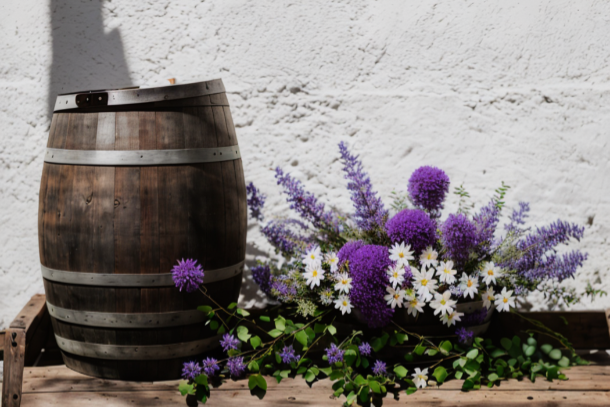Creating Resilient Gardens: An Expert Guide to Drought-Tolerant Landscaping

In an increasingly uncertain climate, the concept of drought tolerance is becoming more pertinent than ever.
Understanding Drought Tolerance
Fundamentally, drought tolerance refers to a plant's ability to withstand dry conditions and periods of low rainfall, which are characteristics increasingly common in many parts of the UK due to climate change. These plants have evolved various physiological and morphological adaptations that allow them to survive in dry environments, such as deep roots, waxy leaf surfaces, and a reduced rate of photosynthesis.
The Science Behind Drought Tolerance
Drought-tolerant plants operate on a simple yet ingenious principle. They are adapted to conserve water, either by storing it in their leaves, stems or roots or by limiting water loss through their leaves. Their inbuilt resilience helps them to thrive even in water-scarce conditions, a characteristic that's making them increasingly attractive to gardeners and landscape architects alike.
The Importance of Drought-Tolerant Landscaping in Modern Times
As climate change redefines weather patterns, drought-tolerant landscaping emerges as a responsible and pragmatic approach to garden design. It's not just about selecting hardy plants but about creating a sustainable environment where flora and fauna can thrive.
Embracing Sustainability in Gardening
Drought-tolerant landscaping not only conserves water – a crucial factor in areas prone to prolonged dry spells – but also reduces maintenance time, helping you to save both resources and energy. Moreover, it supports biodiversity, attracting a wide range of wildlife, from pollinating insects to birds. With drought-tolerant landscaping, you are not just cultivating a garden; you're actively contributing to a more sustainable and climate-resilient future.
Understanding Drought Tolerance in Plants
Definition and Explanation of Drought Tolerance
Drought tolerance in plants is the inherent ability of a plant species to survive and reproduce under reduced water conditions. In the simplest of terms, these plants are adapted to thrive in dry environments where water is scarce. They've evolved various strategies over time to reduce water loss and maximise water uptake, ensuring their survival in drought conditions.
Adaptation Mechanisms of Drought-Tolerant Plants
Plants utilise an array of mechanisms to cope with water stress, a topic of significant importance in the study of plant biology. For instance, they may have deep or extensive root systems capable of reaching water sources far beneath the surface. Some plants may exhibit reduced leaf size or waxy, hairy, or silvery leaf surfaces to minimise water loss through transpiration. Succulent plants store water in their thick, fleshy leaves or stem, providing a reservoir for dry periods.
Benefits of Using Drought-Tolerant Plants in Landscaping
Incorporating drought-tolerant plants into your garden or landscape design presents numerous advantages. Not only do they require less water, reducing both the environmental impact and cost of garden maintenance, but they also provide a unique aesthetic appeal, often adding texture and vibrant colour to your landscape throughout the year. Furthermore, these plants usually demand less care and attention compared to traditional ornamental species, making them an excellent choice for those desiring a low-maintenance garden. They can also play a crucial role in conserving local biodiversity, providing a habitat for local fauna and flora.
Drought-Tolerant Landscaping: Key Elements
Soil Preparation and Water Conservation Techniques
Proper soil preparation is an essential first step in creating a drought-tolerant landscape. Consider conducting a soil test to determine its composition, pH, and nutrient levels. Ideally, the soil should be well-draining as waterlogged conditions can be detrimental to drought-tolerant plants.
If your soil is heavy clay or too sandy, consider amending it with organic matter, such as compost or well-rotted manure, to improve its structure and water-holding capacity. Additionally, a layer of mulch can help to conserve moisture, regulate soil temperature, and reduce weed growth.
Water Conservation Techniques
When it comes to water conservation, implementing an efficient irrigation system can play a significant role. Drip irrigation and soaker hoses are great options for delivering water directly to the plant roots, thereby reducing water wastage. Furthermore, try to water early in the morning or late in the evening to minimise evaporation.
Considerations for Layout and Plant Positioning
The layout of your drought-tolerant landscape should take into consideration the sun and wind exposure of your garden. Position the plants according to their light and heat tolerance levels.
Plant Positioning
For instance, full-sun plants should be placed in areas that receive at least 6 hours of direct sunlight, while shade-loving plants can be tucked away in more sheltered spots. Grouping plants with similar water needs together, a technique known as hydrozoning can further enhance water efficiency. Lastly, the use of hardscape elements, such as rocks or paving, can not only add visual interest but also reduce the area that needs to be watered.
Drought Tolerant Full Sun Plants
An Overview of Full Sun Plants
In the world of horticulture, full-sun plants refer to those plant species that thrive under direct sunlight for a minimum of six hours a day. These plants are accustomed to hot climates, often developed resilience against dry spells, and have unique adaptive features such as waxy leaves, deep roots or succulent stems, which allow them to preserve moisture and survive harsh sun exposure.
Defining Full Sun Plants
A full-sun plant is defined as a plant that requires at least six hours of sunlight per day to grow properly. These plants are well-adapted to endure long hours of sun exposure and often exhibit features such as deep root systems and waxy or hairy leaf surfaces.
Top Drought-Tolerant Full Sun Plants
Choosing plants that can withstand the UK's full sun and occasionally arid conditions will not only conserve water but also add beauty to your garden throughout the year. A few excellent choices include:
-
Lavender: Known for its fragrant purple blooms and grey-green leaves, lavender is a popular choice for its drought and heat tolerance.
-
Sedum: Often referred to as stonecrops, Sedums come in a variety of colours and sizes; they're renowned for their ability to thrive in poor soil conditions and full sun.
-
Echinacea: This perennial, also known as coneflower, can withstand hot, dry weather conditions, making it ideal for sunny, drought-prone gardens.
Caring for Drought-Tolerant Full Sun Plants
Once established, drought-tolerant full-sun plants require minimal maintenance. However, a bit of care in the beginning stages ensures their healthy growth.
-
Watering: While these plants are designed to survive with less water, it's crucial to water them during prolonged dry spells or while they're young and establishing.
-
Mulching: Mulch helps retain soil moisture and keeps the roots cool during hot summer days. Apply a layer around the plants, ensuring it doesn't touch the plant stems.
-
Pruning: Regular pruning helps to maintain the shape of the plants and encourages more flowering. Remove any dead or dying parts to enhance growth.
Drought-Tolerant Shrubs
Introduction to Drought-Tolerant Shrubs
In our ongoing battle with an ever-changing climate, drought-tolerant shrubs offer an ideal solution for maintaining lush and vibrant gardens, even in the face of minimal rainfall. These hardy plants, often native to arid or semi-arid regions, have developed unique mechanisms to withstand prolonged dry periods. With an extensive array of aesthetic forms and colours, they add both texture and intrigue to any landscape.
Popular Varieties of Drought-Tolerant Shrubs
Rosemary (Rosmarinus officinalis)
Loved for its aromatic leaves and vibrant blue flowers, rosemary is a hardy perennial that thrives even in the driest of soils.
Buddleja (Buddleja davidii)
Also known as the butterfly bush, Buddleja is cherished for its fragrant, colourful flowers that attract a wide range of pollinators.
Potentilla (Potentilla fruticosa)
Potentilla is a hardy shrub that produces a riot of charming yellow flowers from early summer through to autumn.
Planting and Maintenance Tips for Drought-Tolerant Shrubs
Planting Tips
To start, it's crucial to ensure your shrubs are planted in well-draining soil, as waterlogged roots can lead to plant diseases. In general, spring is the best time to plant, allowing the shrubs ample time to establish their roots before the winter chill sets in.
Maintenance Tips
Minimal maintenance is part of the appeal of drought-tolerant shrubs. Pruning should be limited, ideally done in late winter or early spring, to maintain the natural form of the plant. Watering should also be conservative - these plants are built to withstand dry periods, after all!
Drought-Tolerant Trees: An Essential Component for Sustainable Landscaping
Understanding the Importance of Drought-Tolerant Trees
Drought-tolerant trees are a vital aspect of any water-wise garden. They not only offer aesthetic benefits but also provide a much-needed habitat for wildlife. Most significantly, these hardy trees have evolved to survive in arid conditions, making them an excellent choice for landscapes facing water shortages or restrictions.
Why Drought-Tolerant Trees Matter
Drought-tolerant trees are beneficial for several reasons. They conserve water, reduce maintenance requirements, and contribute to the preservation of local biodiversity. They can also help to mitigate the effects of climate change by adapting to drier conditions and storing more carbon.
Selection of Suitable Drought-Tolerant Trees
When choosing trees for your landscape, several factors must be considered: local climate, soil type, and personal preference, among others.
Top Choices for UK Gardens
Some drought-tolerant trees suitable for the UK include the English Oak (Quercus robur), the Scots Pine (Pinus sylvestris), and the Silver Birch (Betula pendula). Each of these trees has unique characteristics that make them especially resilient to drought.
Care and Maintenance of Drought-Tolerant Trees
Once established, drought-tolerant trees typically require less care than other trees. However, appropriate planting and initial watering are critical.
Planting and Watering Tips
Plant in the cooler months to give trees the best start and water deeply but infrequently during the first year to encourage deep root growth. After that, they should be well-equipped to handle periods of drought.
Drought-Tolerant Flowers
Benefits of Drought-Tolerant Flowers
Drought-tolerant flowers provide a myriad of benefits for gardeners and landscapers. Primarily, they require less water, which is not only environmentally friendly but also eases the workload and reduces the cost of upkeep. These plants also tend to be resilient, thriving in conditions where other plants may struggle. Their striking appearances and vibrant colours can add beauty to a garden while simultaneously supporting local biodiversity.
Varieties of Drought-Tolerant Flowers to Consider
The variety of drought-tolerant flowers available is wide, giving you ample scope to design your garden. Lavender (Lavandula), known for its pleasing scent and lovely purple flowers, is an excellent choice, as it thrives in full sun and well-drained soil. Similarly, Sedum, also known as stonecrop, offers colourful, dense foliage and requires minimal maintenance. Other options include Coneflower (Echinacea), Butterfly Weed (Asclepias Tuberosa), and Tickseed (Coreopsis), all known for their beautiful blossoms and hardiness in dry conditions.
Tips for Growing Drought-Tolerant Flowers
Cultivating drought-tolerant flowers requires attention to specific details. Firstly, amend your soil with organic matter to improve its water-holding capacity and provide nutrients. While these plants are drought-tolerant, they still need some water - especially during the first year. However, it's crucial not to overwater, as this can lead to root rot. Finally, mulching around your plants can help conserve soil moisture and control weed growth, further supporting your flowers' survival during dry spells.
In conclusion, drought-tolerant flowers provide a sustainable, resilient, and beautiful choice for gardeners in dry climates or those looking to conserve water.
Drought-Tolerant Grasses and Ground Covers
The Role of Drought-Tolerant Grasses and Ground Covers
When considering the design of your drought-tolerant landscape, don't overlook the importance of grasses and ground covers. Not only do these hardy plants contribute to the overall aesthetics, but they also play an integral role in soil conservation. By providing a protective layer over the soil, they can reduce water evaporation and inhibit the growth of water-thirsty weeds.
Selection Criteria
In choosing drought-tolerant grasses and ground covers, consider their compatibility with your local climate, soil type, and overall landscape design. The best selections are those that require less water, resist local pests and diseases, and thrive with minimal maintenance.
Different Types of Drought-Tolerant Grasses and Ground Covers
There is a wide array of drought-tolerant grasses and ground covers suitable for UK gardens.
Grasses
Examples include Blue Fescue (Festuca glauca), with its eye-catching blue-green foliage, and the resilient Zoysia grass, known for its ability to withstand dry spells.
Ground Covers
Among drought-tolerant ground covers, consider Sedums, also known as stonecrops, which come in a wide variety of colours and textures, or Thyme, which is not only drought-tolerant but also releases a pleasant aroma when walked upon.
Cultivating and Maintaining Drought-Tolerant Grasses and Ground Covers
While these plants are built to withstand drier conditions, certain care principles can ensure they thrive in your landscape.
Planting
It's best to plant these species during the cooler months, allowing them to establish before the heat of summer.
Maintenance
Maintenance typically involves minimal watering, occasional weeding, and infrequent mowing (for grasses). Remember, the goal is to support their natural resilience, not to pamper them with excessive care.
By including these robust grasses and ground covers in your landscape, you can create a garden that's not only beautiful but also highly resilient to drought.
Designing a Drought-Tolerant Landscape
Principles of Designing a Drought-Tolerant Landscape
Designing a drought-tolerant landscape requires a shift in traditional gardening mindsets. The central principles are the conservation of water, the creation of shade, and the use of native, drought-tolerant plants. These landscapes are both beautiful and sustainable, requiring far less water than a typical English garden.
Grouping Plants with Similar Water Needs
Planting vegetation with similar water requirements together reduces water usage and simplifies maintenance.
Use of Mulch
Mulch helps retain soil moisture and reduce evaporation; it also adds an aesthetic element to the garden, creating contrasting textures and colours.
Case Studies of Successful Drought-Tolerant Landscapes
Around the UK, many gardeners and landscapers have successfully adopted drought-tolerant principles. For instance, Beth Chatto's Gravel Garden in Essex was created on a site that was never irrigated and has thrived over the years, showcasing an array of drought-tolerant plants.
The RHS Garden Hyde Hall
The Dry Garden at RHS Garden Hyde Hall in Chelmsford is another example. Despite its East Anglian location, it hosts an impressive collection of drought-tolerant plants from around the world.
Expert Tips for Implementing a Drought-Tolerant Landscape Design
Experts recommend starting small, perhaps with a section of your garden, and gradually expanding as you gain experience and confidence. They also advise the careful selection of plants, not just for their drought tolerance but also for their compatibility with your local soil and climate conditions. Lastly, experts emphasize that while a drought-tolerant landscape may require less water, it does not mean 'no water' – all plants require some amount of moisture to survive.
The Future of Drought-Tolerant Landscaping
Technological Advances and Drought-Tolerant Landscaping
As we move forward into the 21st century, the marriage of technology and landscaping is becoming increasingly evident. Cutting-edge technologies are being developed and applied to make gardening and landscaping more sustainable, efficient, and resilient.
Smart Irrigation Systems
For instance, smart irrigation systems utilise sensor technology to measure soil moisture levels accurately, reducing water waste by ensuring plants only receive water when necessary. These systems can be programmed to work in tandem with weather forecasting tools, further improving water efficiency by avoiding irrigation before rainfalls.
Plant Genomics
Moreover, developments in plant genomics are revolutionising the selection and breeding of drought-tolerant plant species. By understanding the genetic basis for drought tolerance, scientists can create new varieties of plants that can withstand extreme conditions, thus expanding the options for drought-tolerant landscaping.
The Role of Drought-Tolerant Landscaping in Climate Resilience
As global warming intensifies, droughts are predicted to become more frequent and severe. Drought-tolerant landscaping plays a crucial role in mitigating the impact of these climatic changes.
Reduction in Water Usage
Firstly, by significantly reducing water usage, drought-tolerant landscaping helps preserve this precious resource, especially in areas prone to water scarcity.
Enhancing Local Biodiversity
Secondly, adopting native, drought-tolerant plants can enhance local biodiversity, providing habitat and food for local wildlife, which can, in turn, increase ecosystem resilience.
Carbon Sequestration
Lastly, plants, especially trees and shrubs, act as natural carbon sinks, absorbing CO2 from the atmosphere and mitigating climate change effects. Therefore, promoting drought-tolerant trees and shrubs in landscaping practices can also contribute to carbon sequestration efforts.
In summary, as we move towards a more environmentally conscious future, the role of drought-tolerant landscaping is set to become ever more significant.
Wrapping Up: A Closer Look at Drought-Tolerant Landscaping
The Relevance and Advantages of Drought-Tolerant Landscaping
Throughout this article, we've traversed the intriguing world of drought-tolerant landscaping, highlighting its pertinence in our current environmental scenario. This sustainable approach to gardening, which prioritises water-efficient plants, has numerous benefits.
Economic and Environmental Perks
Firstly, it contributes significantly to reducing water usage, leading to lower utility bills. This is particularly beneficial for regions in the UK where water scarcity can be a concern during dry spells. Furthermore, it reduces the dependency on water resources, hence playing a vital role in conserving our environment.
Aesthetic and Biodiversity Values
Beyond functionality, drought-tolerant landscapes can offer aesthetic appeal with a diverse range of shrubs, trees, and flowers that are resilient yet attractive. Simultaneously, these landscapes can bolster local biodiversity by providing habitats and food sources for a variety of wildlife.
Nurturing a Future with Drought-Tolerant Landscaping
Embracing Sustainability
We strongly encourage everyone, from seasoned gardeners to budding green thumbs, to delve further into drought-tolerant landscaping. It represents an opportunity to integrate environmental sustainability with our daily lives whilst keeping our gardens looking splendid.
Learning and Implementing
There are myriad resources available, from local nurseries to online forums, that can guide you in choosing the right drought-tolerant plants suitable for your area and specific garden conditions. Remember, every small step towards implementing these practices contributes to a larger cause of water conservation and a greener future.
In conclusion, it is imperative that we adapt our gardening habits to align with the changing climate. By adopting drought-tolerant landscaping, we are not just gardening but nurturing a sustainable future for generations to come.
References and Useful Resources
Cited Sources and Additional Reading Materials
To broaden your knowledge on drought-tolerant landscaping and related topics, consider the following resources:
Gardening in a Drought by Sue Minter
This essential guide provides an in-depth discussion on sustainable gardening in the face of drought conditions. Minter, an experienced horticulturist, shares insights on plant selection, soil management, and water conservation techniques.
Planting in a Post-Wild World by Thomas Rainer and Claudia West
This compelling read delves into the concept of designing plant communities for resilient, beautiful, and diverse gardens, even under challenging weather conditions.
RHS: Drought Resistant Planting
The Royal Horticultural Society's webpage on drought-resistant planting provides a comprehensive list of plants and trees that can tolerate dry conditions. The RHS is a key authority in the UK on all things horticulture, making this an essential resource.
Directory of Suppliers for Drought-Tolerant Plants and Materials
For those ready to embark on their drought-tolerant landscaping journey, consider the following UK-based suppliers:
Ashridge Nurseries
An online garden centre with an excellent selection of drought-tolerant plants, trees, and shrubs. They offer nationwide delivery and have an extensive range that caters to a variety of gardening needs.
Crocus
A well-stocked online garden shop offers a broad selection of plants suited to drier conditions. They also provide insightful tips and guidance on plant care.
Beth Chatto’s Plants & Gardens
Beth Chatto was a pioneer in dry garden planting in the UK. Her nursery offers an extensive range of drought-resistant plants, and her gardens serve as a living testament to the beauty of drought-tolerant landscaping.
I do hope you have enjoyed this article and hope that you will subscribe to my newsletter so you can get the latest information about all things naturally relaxing.
Stay in touch, join the Naturally Relaxing Newsletter
Newsletter Signup
Post Your Comments
or post as a guest
Be the first to comment.
Latest articles in Water
Idea is to do article on waterfall

Finding the Perfect Swimming Hole: Your Comprehensive Guide

Exploring Sea Deities Around the World: A Dive into Global Mythologies

Harvesting Rainwater: A Comprehensive Guide to Rain Barrels and Water Storage

The Bottled Water Dilemma: How Many Bottles Do You Need for a Gallon?






